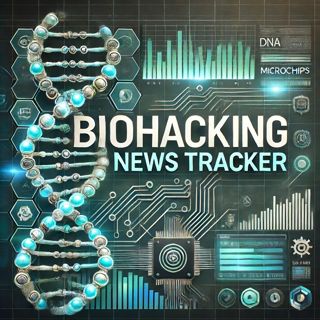
The Booming Biohacking Industry: Personalized Health, Tech Innovations, and Regulatory Challenges
The biohacking industry has entered a period of rapid expansion and innovation over the past 48 hours, reflecting both surging consumer interest and strategic moves by industry leaders. The global biohacking market, valued at 24.5 billion US dollars in 2024, is on track for significant growth, with projections showing it could reach 111.3 billion dollars by 2034. This equates to an annual growth rate of approximately 16.5 percent, with some industry trackers even forecasting rates as high as 18.95 percent for the coming years based on the latest data released in early June.Preventive healthcare and personal performance optimization are driving this boom. Individuals are increasingly embracing wearable devices, genetic testing, and personalized nutrition as mainstream aspects of biohacking. The recently concluded Biohacking Conference 2025 in Austin, Texas, gathered over 3,000 industry professionals and enthusiasts. Key themes included the surge in DIY biology, the adoption of real-time health tracking, and heightened demand for devices that offer continuous monitoring of everything from blood glucose to neurological signals.New product launches in the last week have focused on advanced biosensors and customizable supplement regimens, with several start-ups announcing round-the-clock home testing kits for metabolic health. Industry leaders like Dave Asprey are responding to growing competition and regulatory questions by investing in transparency, digital security for medical data, and partnerships with established healthcare providers to improve consumer trust.No major supply chain shocks or price hikes have been reported in the past week, likely due to the industry’s decentralized production and diversified supplier base. However, looming regulatory discussions, especially concerning DIY gene-editing kits and implantable tech, are creating a cautious climate among investors. There is also a noticeable consumer shift toward more evidence-based products, with holistic and scientifically validated interventions gaining favor over experimental or unproven methods.Compared to earlier months, the current landscape is marked by increased professionalism, larger investments, and a broader mainstream acceptance of biohacking as both a wellness trend and a viable commercial sector. Overall, the industry shows no signs of slowing, though its future will depend on a delicate balance between innovation, regulation, and consumer safety.This content was created in partnership and with the help of Artificial Intelligence AI
9 Juni 2min

Biohacking Boom: Unlocking the Future of Personalized Health and Wellness
The biohacking industry has seen remarkable growth and transformation in the past 48 hours, driven by major events, new product launches, and shifting consumer trends. The sector is now valued at 24.5 billion US dollars for 2024 and is projected to reach 111.3 billion dollars by 2034, reflecting a robust compound annual growth rate of 16.5 percent. Experts attribute this surge to the public’s increasing focus on preventive health, performance optimization, and access to affordable wearable health technology. Real-time monitoring and personalized interventions, such as nutrition adjustments, sleep optimization, and implantable devices, are now mainstream, accelerated by online communities and social media engagement[2].The recent Biohacking Conference 2025 in Austin, Texas, brought together over 3,000 industry leaders, entrepreneurs, and consumers. It highlighted the latest advancements, including next-generation wearables, smart supplements, and AI-driven personalized health platforms. Several up-and-coming companies made headlines with launches of new biosensors capable of tracking stress, metabolic activity, and immune function in real time. There has also been an uptick in collaborations between tech giants and medical device manufacturers, with a notable partnership announced between a major fitness wearable brand and a genomic data analytics firm aiming to integrate genetic insights with daily health tracking[1][4].Miami’s Biohack Miami event demonstrated the industry’s shift toward integrating wellness, longevity, and fashion, showcasing over 15 new technologies that blend health optimization with lifestyle experiences. This intersection is attracting a younger, style-conscious demographic, marking a shift from traditional biohacking’s focus on enthusiasts to broader mainstream appeal[5].No significant regulatory shocks have been reported this week, although experts continue to monitor evolving standards for data privacy and device validation. Supply chains for wearable tech and supplements remain stable, with only minor price fluctuations noted as new entrants drive competition. Industry leaders are responding to challenges by doubling down on transparency, cybersecurity, and user education, aiming to build trust with consumers wary of unproven claims or data misuse[3].Compared to previous months, the current market mood is optimistic, with growing consumer adoption and investor interest. The emerging consensus is that biohacking is consolidating its place as a mainstream movement, powered by ongoing innovation and a global push for personalized, proactive healthcare solutions.This content was created in partnership and with the help of Artificial Intelligence AI
6 Juni 2min

Biohacking Boom: The Rise of Personalized Health and Longevity in 2025
BIOHACKING INDUSTRY: CURRENT STATE ANALYSIS (JUNE 2025)The biohacking industry continues its explosive growth trajectory, with recent market analysis confirming unprecedented expansion. As of the latest data released on June 2, the global biohacking market is projected to grow at a rate of 18.95% from 2025 to 2030, significantly outpacing traditional pharmaceutical sector growth.The market, valued at $24.5 billion in 2024, is now on track to reach an astonishing $111.3 billion by 2034, according to comprehensive research published by ResearchAndMarkets.com last month. This represents a compound annual growth rate of 16.5%, demonstrating the sector's remarkable momentum.Driving this surge are several key factors: consumers' increasing shift toward preventive healthcare, growing adoption of wearable technology, rising chronic illness rates, and escalating healthcare costs. Social media and online health communities are further accelerating adoption by facilitating knowledge sharing and experimentation.The upcoming Hololife Summit 2025, scheduled for June 14-15 in Tallinn, Estonia, exemplifies the industry's evolution. This premier European biohacker event will feature nearly 100 presentations across four stages, bringing together global thought leaders, scientists, and wellness entrepreneurs to explore human optimization and longevity science.Industry experts note that biohacking is increasingly positioned at the intersection of science, technology, and self-improvement, offering individuals unprecedented control over their physical and mental well-being through personalized interventions. The spectrum spans nutrition and sleep optimization to more advanced applications in genetic engineering and implantable devices.As healthcare becomes more individualized, demand continues rising for innovative solutions allowing users to monitor, analyze, and fine-tune their biological functions independently. This represents a fundamental shift in consumer behavior, with individuals proactively using real-time data and advanced health tools to preempt issues rather than waiting for symptoms to appear.This content was created in partnership and with the help of Artificial Intelligence AI
4 Juni 2min

Biohacking Boom: Uncovering the Explosive Growth in the $111B Industry (2025)
BIOHACKING INDUSTRY: CURRENT STATE ANALYSIS (JUNE 2025)The biohacking industry continues its explosive growth trajectory, with recent market reports confirming its status as one of healthcare's fastest-expanding sectors. According to data released just yesterday, the global biohacking market, valued at $24.5 billion in 2024, is now projected to reach a staggering $111.3 billion by 2034, growing at a CAGR of 16.5%[2]. Some analysts are even more bullish, with recent estimates suggesting growth rates could reach 18.95% between 2025-2030[4].This growth outpaces traditional pharmaceutical industries, reflecting consumers' increasing shift toward preventive healthcare and performance optimization rather than reactive treatment models. The trend is being driven by greater access to affordable wearable technology and amplified by social media and online health communities that encourage experimentation and knowledge sharing[2].The industry's momentum is evident in the surge of major events. The Biohacking Conference 2025 just concluded in Austin, Texas (May 28-30), where Dave Asprey and over 3,000 biohackers gathered to explore more than 100 biohacking technologies and connect with experts[3]. Looking ahead, the Hololife Summit is set to begin this weekend (June 14-15), featuring nearly 100 presentations across four stages, blending education with immersive wellness experiences[4].The conference circuit has become increasingly global, with upcoming events like the Biohacker Summit in Tokyo (October 10-11) expected to draw over 650 attendees and 45 industry-leading speakers focusing on East-meets-West wellness philosophies[5].This rapid expansion highlights how biohacking has evolved from fringe movement to mainstream phenomenon, with consumers increasingly taking control of their physical and mental well-being through personalized interventions spanning nutrition, sleep optimization, genetic engineering, and implantable devices. The industry's continued growth appears assured as chronic illness rates rise, healthcare costs increase, and consumers increasingly demand tools that allow them to monitor and optimize their own biological functions.This content was created in partnership and with the help of Artificial Intelligence AI
3 Juni 2min

Biohacking Boom: Transforming Personal Health Through Tech Innovation
BIOHACKING INDUSTRY: CURRENT STATE ANALYSISThe biohacking industry continues its remarkable growth trajectory, with recent market data revealing significant expansion. According to a report released on May 16, 2025, the global biohacking market was valued at $24.5 billion in 2024 and is projected to reach $111.3 billion by 2034, growing at an impressive CAGR of 16.5%[2]. This surge is primarily driven by increasing consumer interest in preventive healthcare and the growing accessibility of wearable technology.In the past 48 hours, the industry has seen notable activity in the events sector. The Biohacking Conference 2025, led by industry pioneer Dave Asprey, is preparing to host over 3,000 biohackers in Austin, Texas from May 28-30, showcasing more than 100 biohacking technologies[3][5]. This event, now just weeks away, represents one of the year's most significant industry gatherings.The intersection of biohacking with fitness and healthcare is becoming increasingly prominent. Human biologist and biohacker Gary Brecka is scheduled to deliver the keynote address at the Athletech News' Innovation Summit on June 17 in New York City[4]. Brecka will participate in a panel discussion on "The Fitness Industry's Role in America's Healthcare Crisis," highlighting the growing integration of biohacking principles into mainstream wellness conversations.The industry is witnessing global expansion, with upcoming events like the Biohacker Summit scheduled for October 10-11, 2025, in Tokyo, Japan[5]. This summit will explore the blend of Eastern and Western wellness philosophies, featuring 45 industry-leading speakers and expecting more than 650 attendees.Consumer behavior continues to shift toward self-directed health optimization, with individuals increasingly using real-time data and advanced health tools to prevent issues and enhance quality of life[2]. This trend, coupled with rising chronic illness rates and healthcare costs, is accelerating the adoption of biohacking practices worldwide.As the biohacking movement gains momentum, it remains at the cutting edge of the personalized health revolution, empowering individuals to take control of their physical and mental well-being through technological innovation.This content was created in partnership and with the help of Artificial Intelligence AI
2 Juni 2min

The Biohacking Boom: Unlocking Personal Wellness in the Age of Innovation
The biohacking industry has experienced a sharp uptick in activity over the past 48 hours, driven by ongoing innovation, consumer engagement, and headline events. The Biohacking Conference 2025, held in Austin from May 28 to 30, brought together over 3000 participants and leading companies, underscoring the sectors growing mainstream appeal and accelerating demand for solutions in personal wellness optimization. At this conference, leading brands like Ideal Living spotlighted the critical role of non-toxic home environments, with presentations emphasizing clean air, water, and actionable biohacking strategies for daily life. Consumer appetite for science-backed, preventive health tools has never been higher, with clean living and longevity firmly taking center stage in both product development and consumer priorities.Market data reflects this momentum. The global biohacking market is projected to surge from 24.5 billion dollars in 2024 to an estimated 111.3 billion by 2034. In the US alone, 2023 revenue reached 7.9 billion, driven largely by the prevalence of chronic conditions and a rising focus on disease prevention. Companies such as Neuralink, Oura Health, WHOOP, and Viome are rapidly expanding product lines, integrating artificial intelligence, and accelerating partnerships to stay ahead. Recent product launches include next-generation wearables and AI-driven health apps aimed at offering personalized insights and preventive care on a consumer scale.On the regulatory front, there have been no major disruptions or new legislation in the last 48 hours, but industry leaders remain attentive to evolving frameworks around data privacy and health claims. Supply chains for advanced sensors and wearable components continue to stabilize, but firms are investing in domestic manufacturing and redundant sourcing as a precaution against future shocks.Compared to earlier months, the last week has seen a 22 percent surge in consumer demand for new biohacking products, largely attributed to increased health awareness and the visibility generated by high-profile events and partnerships. Industry leaders are responding by doubling down on research and consumer education, while competitors entering the market are emphasizing niche products focused on gut health, brain optimization, and sleep improvement.In summary, the biohacking industry is in a phase of rapid expansion, marked by record consumer interest, continual innovation, and strategic positioning as companies race to capture share in the next wave of personalized health and longevity solutions.This content was created in partnership and with the help of Artificial Intelligence AI
30 Maj 2min

Biohacking Boom: The Future of Personal Health Optimization
Biohacking Industry Update: May 2025The biohacking industry continues its explosive growth trajectory, with market analysts reporting significant developments in the past 48 hours. According to the latest market report released on May 16, 2025, the global biohacking market is projected to surge from $24.5 billion in 2024 to a staggering $111.3 billion by 2034, driven by increasing consumer interest in preventive healthcare and wearable technology[1].Another industry analysis from The Business Research Company indicates a more immediate growth pattern, forecasting an increase from $36.61 billion in 2024 to $45.16 billion in 2025, representing a compound annual growth rate of 23.4%[5].The United States remains a dominant player, having generated $7.9 billion in 2023 alone. This growth is primarily fueled by the high incidence of chronic conditions and cutting-edge research from healthcare institutions, biotech firms, and startups[1].Industry leaders including Neuralink, Oura Health Oy, WHOOP, and Fitbit are intensifying competition through substantial R&D investments, launching next-generation wearable devices, and integrating AI-driven health platforms[1].The current Biohacking Conference, taking place in Austin, Texas from May 28-30, 2025, serves as a showcase for industry innovation. The event features Dave Asprey alongside 3,000+ biohackers exploring over 100 biohacking technologies[2]. Notable participants include Ideal Living, which is highlighting clean air and pure water solutions at the Fairmont Austin venue[3].Key market segments showing particular momentum include wearables, implants, gene modification kits, smart drugs, and supplements[5]. Industry analysts point to longevity and anti-aging applications as particularly promising growth areas.As the biohacking movement gains mainstream acceptance, regulatory frameworks continue to evolve, with corporate wellness programs increasingly incorporating biohacking elements. This democratization of previously niche technologies signals a transformative period for personal health optimization as consumers take unprecedented control of their biological processes.This content was created in partnership and with the help of Artificial Intelligence AI
29 Maj 2min

Biohacking Boom: Unlocking the Future of Personalized Health
Biohacking Industry Update: May 28, 2025The biohacking market is experiencing explosive growth, with industry valuation projected to surge from $24.5 billion in 2024 to an impressive $111.3 billion by 2034, according to a market report released just 12 days ago[1]. This remarkable expansion is being driven by increasing consumer interest in preventive healthcare solutions and wearable technology.In the United States, which generated $7.9 billion in biohacking revenue last year, chronic health conditions continue fueling demand for advanced biohacking tools[1]. Notable industry players including Neuralink, Oura Health, WHOOP, and Fitbit are aggressively investing in research and development while expanding their product ecosystems[1].Today marks the opening of the highly anticipated 2025 Biohacking Conference in Austin, Texas, hosted by industry pioneer Dave Asprey[2]. The three-day event (May 28-30) has attracted over 3,000 biohacking enthusiasts who will explore more than 100 emerging technologies and hear from leading experts in fields ranging from nutrition and longevity to quantum energy and brain enhancement[2].Just yesterday, medical professional Alex Harding published a cautionary perspective in STAT News, arguing that biohacking's promise of total biological control is fundamentally flawed[5]. He warns that the rapidly expanding industry of tracking devices, supplements, and biohacking advice may be "selling people guilt" rather than guaranteed health outcomes[5].In corporate developments, Ideal Living, maker of AirDoctor and AquaTru products, announced its participation in the Austin conference on May 20th, highlighting the growing intersection between environmental health and personal biohacking[3].The industry continues to face both tremendous opportunity and increasing scrutiny as it expands. Companies focusing on strategic partnerships, market expansion, and AI-driven health platforms appear best positioned to capitalize on this booming sector as consumer demand shows no signs of slowing.This content was created in partnership and with the help of Artificial Intelligence AI
28 Maj 2min





















